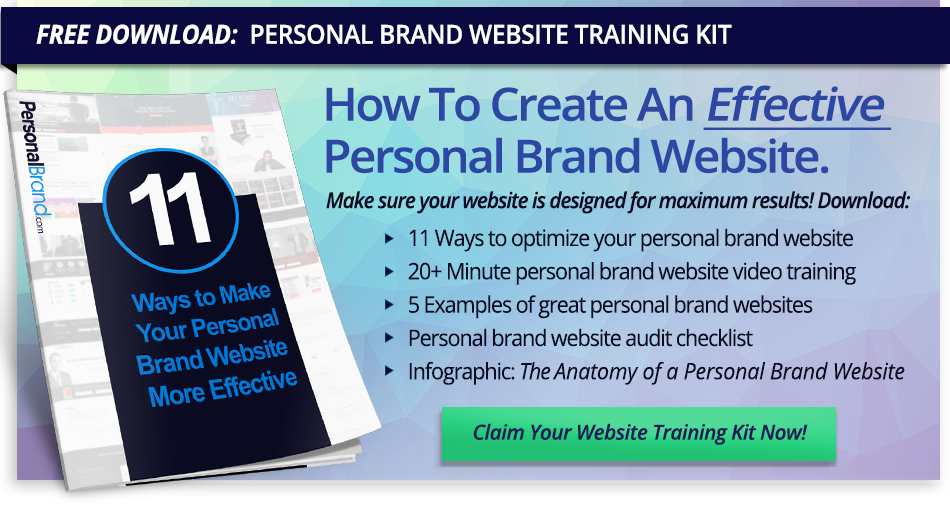How to Create an Elevator Pitch for Your Personal Brand
You know all the things that make your personal brand awesome, but do you know how to communicate that concisely and in a compelling way to those you meet? Opportunities to share your personal brand with others can happen at any time and lead directly to new clients, speaking opportunities and more. It’s all about that elevator pitch!
In business, an elevator pitch is a 30-seconds-or-less description of an idea or product that clearly explains it and makes the listener want to learn more. For your personal brand, your elevator pitch explains:
- What makes you unique
- What makes you valuable
- What your goals are
Can you state all this in less than a minute? Definitely.
And in fast-paced networking environments like conferences and mixers (or even, yes, a ride up an elevator), a solid elevator pitch can be the difference between an acquaintance getting to know you more or that person moving on to someone else.
Why is an elevator pitch for your personal brand important?
According to Business Insider, at least 70 percent of jobs are not listed publicly. And up to 85 percent of open positions are filled through networking. Using your elevator pitch is a way to expand your network and opportunities.
Here’s a breakdown of the components of an effective elevator pitch, including what to consider before diving in, as well as specifically what to touch upon in your pitch!
Consider This When Crafting and Delivering Your Elevator Pitch
The goal of your elevator pitch should be to get the person you’re talking to intrigued in what you have to offer and to want to learn more. You might want to have several elevator pitches, depending on the situation.
Consider the following types of elevator pitches:
- A general elevator pitch for when you’re meeting a stranger in an unexpected setting
- An elevator pitch for a networking event geared towards certain types of professionals
- An elevator pitch for when you are up for a specific role, like when you’re trying to land a new client or be chosen as a speaker for an event
What to Include in Your Elevator Pitch
Your elevator pitch should be around four to five sentences. You can easily get to the point in less than a minute, while still providing enough detail to pique interest.
Here are the components to include in your elevator pitch. Write a detailed sentence for each component.
- A definition of who you are, what makes you unique and how you bring value.
- Relevant skills, experience or accomplishments. To be more relatable and memorable, make these anecdotal and specific. Don’t mention skills you’re lacking or what you still need to learn.
- What do your strengths-in-action look like? Go beyond labeling yourself. Explain what problems you solve, and what that looks like.
- Your ‘why’ – what are your values, and how do they drive what you do?
- Who do you aim to serve?
You can end your elevator pitch with a relevant call to action that fits the situation.
If you meet someone you’re interested in working for, hand them a business card and invite them to check out your website. Or, ask if you can send them your résumé or electronic press kit.
You can also ask your new contact for their email address so that you can keep in touch. Be sure to follow-up online to keep the conversation going.
Remember: your elevator pitch for your personal brand serves as a means to an end. Proactively nurture the relationship once you’ve secured their attention and interest.
Tips for Making an Elevator Pitch Effective
If you’ve already created a personal brand statement and personal brand value proposition, use those as inspiration for your elevator pitch. Your messaging is already in place, and ready for you to succinctly share with others!
The key is to make your elevator pitch conversational and natural.
Use these tips:
1. Keep Your Pitch Focused
You may have 30 years of experience across diverse verticals with strikingly different job titles. You can’t go into that much detail with your elevator pitch. Stick to one or two specific areas of your current work or goals to hone in on in your pitch.
2. Grab Attention and Make It Memorable
Think about what you can say that will make the person remember your elevator pitch, especially if they’ll be hearing many throughout an event. Lead with something interesting, or ask a question the listener can relate to.
For example, if you’re a website designer for ecommerce stores, you might lead with, “Have you heard about how ecommerce is on pace to make up 15 percent of retail sales by 2020? I’m a web designer helping brick and mortars open online stores and reach customers around the globe, so they can continue to maintain sales momentum in the changing retail world.”
Add attention-grabbing details, like statistics or the specific community you serve. Infuse your personality into your pitch. Don’t be afraid to be witty or show off your passion. An elevator pitch serves as an opportunity to share your distilled message, with a pop of your humanity.
Not only that, but delivering a memorable pitch to people in-person pairs well with word-of-mouth marketing! You never know if the person standing before you is the very influencer who will share you and your message with their audience, catapulting your brand to an entirely new level of impact and growth. Bring that commitment to distinction into every elevator pitch.
3. Aim to Connect, Not to Sell
Even though your elevator pitch is geared to sell your personal brand, the best way to do that is to lead with what’s in it for the listener. Make the pitch focused on the value you bring to the audience, conveying how what you’re pitching will help them.
4. Make the Pitch Simple and Universally Accessible
Don’t assume the person you’re talking to has as sophisticated a vocabulary as you, or knows the meaning behind industry acronyms you’re tempted to use. Write the pitch to be easy to understand by using simple and universally accessible language.
There’s a difference between leaving your listener confused vs. leaving your listener interested.
5. Practice Your Pitch
Practicing your general pitch is a good idea since you never know who you’ll meet. Being able to confidently state who you are, what you do, the value you bring and what makes you unique can pay off in unexpected ways.
Film yourself delivering your pitch so that you can see how you come across. Then, optimize your pitch.
If you are using your elevator pitch in a specific setting, such as when you’re seeking an investor, practice your tailored pitch beforehand with someone you trust to get feedback.
As you practice, try to avoid these elevator pitch pitfalls:
- Speaking too quickly
- Rambling or repeating yourself
- Speaking without emotion or with a negative emotion
Writing out your pitch is so helpful for practicing because you can easily tweak what you’re saying and then work on perfecting the delivery. Each time you practice, envision you’re talking with someone you enjoy being around, not someone you’re intimidated by.
End on a High Note
Write your pitch with the intent to keep the conversation going.
Even though your elevator pitch is designed to introduce yourself and get someone interested, you should follow up your elevator pitch by asking your new contact about themselves, or if they can relate to something you brought up in your pitch.
For example, if you work in corporate training and development, you could ask, “What is the training and development track like at your business?”
Ask questions and show interest in who you’re pitching to. This will lead to building a relationship that’s mutually beneficial. For someone who’s hearing multiple pitches at an event, you can stand out with reciprocity!
Express interest and curiosity about their work and goals, while also offering them distilled information about you and what you’re after in the world. Leverage the elevator pitch for both components, and watch how you elevate your personal brand as a result!
If you enjoyed this post, be sure to join our private, Personal Brand Builders Community to stay up-to-date on the latest tools, strategies, and best practices for building your personal brand. It’s free… and awesome!
We hope you enjoyed this article, thanks for reading! Also, follow us on Facebook, and Twitter for updates every time we publish!


